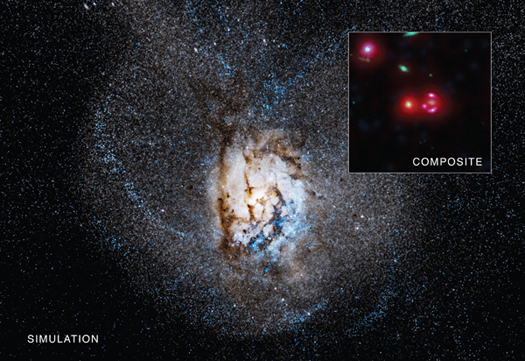For Release: December 8, 2016
CXC

Credit: X-ray: NASA/CXC/Univ of Florida/J.Ma et al; Optical: NASA/STScI; Infrared: NASA/JPL-Caltech; Radio: ESO/NAOJ/NRAO/ALMA
Press Image and Caption
Astronomers have used NASA's Chandra X-ray Observatory and other telescopes to show that a recently-discovered galaxy is undergoing an extraordinary boom of stellar construction. The galaxy is 12.7 billion light years from Earth, seen at a critical stage in the evolution of galaxies about a billion years after the Big Bang.
After astronomers discovered the galaxy, known as SPT 0346-52, with the National Science Foundation's South Pole Telescope (SPT), they observed it with several space and other ground-based telescopes. Data from the international Atacama Large Millimeter/submillimeter Array (ALMA) previously revealed extremely bright infrared emission, suggesting that the galaxy is undergoing a tremendous burst of star birth.
However, an alternative explanation remained: Was much of the infrared emission instead caused by a rapidly growing supermassive black hole at the galaxy's center? Gas falling towards the black hole would become much hotter and brighter, causing surrounding dust and gas to glow in infrared light. To explore this possibility, researchers used NASA’s Chandra X-ray Observatory and CSIRO’s Australia Telescope Compact Array, a radio telescope.
No X-rays or radio waves were detected, so astronomers were able to rule out a black hole being responsible for most of the bright infrared light.
"We now know that this galaxy doesn't have a gorging black hole, but instead is shining brightly with the light from newborn stars," said Jingzhe Ma of the University of Florida in Gainesville, Florida, who led the new study. "This gives us information about how galaxies and the stars within them evolve during some of the earliest times in the Universe."
Stars are forming at a rate of about 4,500 times the mass of the Sun every year in SPT0346-52, one of the highest rates seen in a galaxy. This is in contrast to a galaxy like the Milky Way that only forms about one solar mass of new stars per year.
"Astronomers call galaxies with lots of star formation 'starburst' galaxies," said co-author Anthony Gonzalez, also of the University of Florida. "That term doesn’t seem to do this galaxy justice, so we are calling it a 'hyper-starburst' galaxy."
The high rate of star formation implies that a large reservoir of cool gas in the galaxy is being converted into stars with unusually high efficiency.
Astronomers hope that by studying more galaxies like SPT0346-52 they will learn more about the formation and growth of massive galaxies and the supermassive black holes at their centers.
"For decades, astronomers have known that supermassive black holes and the stars in their host galaxies grow together," said co-author Joaquin Vieira of the University of Illinois at Urbana-Champaign. "Exactly why they do this is still a mystery. SPT0346-52 is interesting because we have observed an incredible burst of stars forming, and yet found no evidence for a growing supermassive black hole. We would really like to study this galaxy in greater detail and understand what triggered the star formation and how that affects the growth of the black hole."
SPT0346-52 is part of a population of strong gravitationally-lensed galaxies discovered with the SPT. SPT0346-52 appears about six times brighter than it would without gravitational lensing, which enables astronomers to see more details than would otherwise be possible.
A paper describing these results appears in a recent issue of The Astrophysical Journal and is available online. NASA's Marshall Space Flight Center in Huntsville, Alabama, manages the Chandra program for NASA's Science Mission Directorate in Washington. The Smithsonian Astrophysical Observatory in Cambridge, Massachusetts, controls Chandra’s science and flight operations.
An interactive image, a podcast, and a video about the findings are available at:http://chandra.si.edu
For more Chandra images, multimedia and related materials, visit:
http://www.nasa.gov/chandra
Media contacts:
Megan Watzke
Chandra X-ray Center, Cambridge, Mass.
617-496-7998
mwatzke@cfa.harvard.edu



Visitor Comments (5)
Hi Jordan Fontenello.
From what I have read and studied it seems that galaxies generally keep their shape and change only when merging or have already done so.
There are dynamics that keeps a rotating galaxy in it's shape while the stars orbit the center of the galaxy traveling through the various arms.
I do not claim to be an expert on this but do much reading and study on various areas of astronomy, astrophysics, and cosmology.
Marvin
Posted by Marvin L. Stacks on Wednesday, 08.16.17 @ 15:55pm
I am wondering if anyone has any thoughts on or has done any modeling of what the galaxy looks like NOW as opposed to how we are seeing it, which is essentially what it looked like 13 billion years ago. What does it look like RIGHT NOW? If we were to be able to instantly travel to that area of space, how would it appear now, 13 billion years later?
Posted by Jordan Fontenello on Tuesday, 05.2.17 @ 13:56pm
How wonderful, I've always enjoyed the images that show up on my email program.
How do I get my grandchildren involved with the same?
Posted by Stephen Gordon on Thursday, 01.12.17 @ 23:48pm
It is incredible to see such a distant object from wildly different perspectives, all from one vantage point that uses another massive object very far away as a mean to peer in on the otherwise-hidden object from different angles. Almost unreal to come to terms with in one's head...
It's 2016 right, Not 3016
Posted by Ben on Friday, 12.9.16 @ 21:48pm
What are the two green ovals, slightly to the left and above the lensed images of SPT 0346-52, and the round bright magenta spot in the upper left corner, are these galaxies unrelated to the SPT 0346-52? Thanks
Posted by Bondybey on Friday, 12.9.16 @ 10:06am